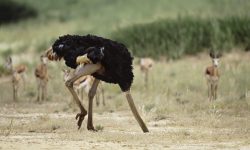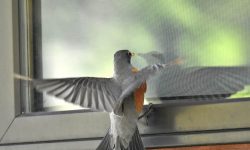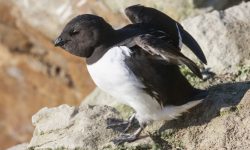The Song Thrush (Turdus philomelos) is often praised for its sweet, repetitive song that fills forests and gardens in spring and summer. But behind its charming melody lies a bird of sharp intelligence, ecological value, and evolutionary adaptability—especially when it comes to diet.
This deep-dive explores the dietary habits of the Song Thrush through multiple scientific lenses: anatomical specialization, behavioral strategies, seasonal adaptation, ecological roles, and even cultural transmission of feeding behaviors.

Anatomical Adaptations for Feeding
Vision and Coordination
Song Thrushes rely heavily on visual cues when foraging. Their large, forward-facing eyes provide excellent binocular vision, crucial for detecting subtle movement in leaf litter and moist soil. Their head-cocking behavior isn’t just a quirky pose—it helps optimize sound localization, enabling them to detect underground prey like worms.
Beak Structure
The moderately slender, pointed beak of the Song Thrush is adapted for two key feeding functions:
-
Probing into soft substrates (soil, moss, leaf litter) to extract invertebrates
-
Precision grasping and manipulation, such as extracting snails from shells
This beak is not suited for cracking hard seeds but is highly effective for soft-bodied prey and small fruits.
Key Animal-Based Foods
Earthworms: High-Protein Foundation
Earthworms (e.g., Lumbricus terrestris) make up a major part of the Song Thrush’s diet in moist habitats. These annelids offer a complete protein source with balanced amino acids and are easily digestible for chicks.
Behavioral studies show that Song Thrushes use a combination of sight and soil vibration sensitivity to detect worms. They often forage during low-light periods (morning/evening), when worms are closer to the surface.
Insects and Larvae: Seasonal Surge
Insect consumption peaks during the breeding season. Song Thrushes target larvae, beetles, spiders, and millipedes, which are nutrient-dense and often found under rotting logs or decaying plant matter.
Scientific observations suggest that thrushes exhibit prey selection—they prefer soft-bodied larvae over hard-shelled beetles for nestlings, reflecting an understanding of chick digestive limitations.
Mollusks: Snails and the Use of Anvils
One of the most compelling behaviors in Song Thrushes is their consumption of terrestrial snails, such as Cepaea nemoralis. These snails are high in calcium, which is critical for egg production and bone development in chicks.
To access the meat, thrushes transport snails to a hard surface (often a favored “anvil stone”) and repeatedly strike them until the shell shatters. This behavior involves:
-
Spatial memory (returning to the same anvil)
-
Force modulation (adjusting peck intensity)
-
Tool use, or at least environmental manipulation
This is a rare example of proto-tool use in a passerine bird and may represent cultural learning, passed down through generations by observation.
Plant-Based Components
Wild Berries: Energy-Dense and Seasonal
As autumn approaches, Song Thrushes switch from invertebrate hunting to carbohydrate-rich berries. Berries such as rowan, hawthorn, and elder are crucial for building fat reserves in preparation for winter or migration.
These fruits contain:
-
Simple sugars (glucose, fructose) for energy
-
Antioxidants (anthocyanins, flavonoids) that may enhance immune function
-
Low water content, minimizing risk of freezing in gut during cold snaps
Thrushes prefer berries that are soft and easily swallowed whole, avoiding large or tough-skinned fruits.
Orchard Fruits: Opportunistic Adaptation
While not part of their ancestral diet, Song Thrushes now consume:
-
Fallen apples, pears, and plums
-
Soft grapes and cherries
-
Fermenting fruits (sometimes leading to mild intoxication)
This shift highlights their behavioral plasticity, allowing them to exploit anthropogenic (human-altered) environments without losing their core foraging behaviors.
Seasonal Shifts and Metabolic Demands
Spring and Summer: Protein and Calcium
Breeding increases energy demands up to double basal metabolic rate (BMR). Females require calcium-rich prey for eggshell production, making snails essential. Nestlings require easily digestible, protein-dense prey, pushing parents to hunt intensively.
Autumn: Energy Storage
Migratory individuals must double their fat stores, so they prioritize berries with high sugar content and digestive speed. Research shows they can detect ripening fruits by color contrast, suggesting evolved fruit-selection cues.
Winter: Scarcity Survival
In cold months, Song Thrushes rely on persistent berries (e.g., holly, ivy) and garden scraps like raisins or suet. The absence of earthworms in frozen ground makes dietary switching essential.
Survival depends on:
-
Stored fat
-
Defended food patches (territoriality increases)
-
Memory of food locations (cognitive mapping)
Behavioral Ecology
Foraging Strategies
Song Thrushes employ search-and-pounce tactics on the ground. They rarely hover or hang like tit species; instead, they use:
-
Leaf flipping
-
Slow stalking
-
Head tilting (combining sight and sound)
They also engage in mobbing behavior when food sources (e.g., fruiting bushes) are highly contested by conspecifics or other thrush species.
Territorial Feeding and Memory
In winter, individuals defend fruit-rich territories. Males and females alike can become aggressively territorial, engaging in:
-
Wing flicks
-
Loud alarm calls
-
Physical chases
There is evidence of episodic memory—birds return to the same fruiting trees across years.
Role in the Ecosystem
Pest Control
By consuming larvae, slugs, and snails, Song Thrushes naturally regulate pest populations. In agricultural zones, their presence can reduce the need for chemical pesticides, especially against leaf-eating caterpillars.
Seed Dispersal
As frugivores, Song Thrushes swallow berries whole and excrete seeds at a distance, often far from the parent plant. This process:
-
Increases plant dispersal range
-
Reduces seed predation (by moving seeds away from competitors)
-
Enhances genetic diversity in native shrubs
Cultural Learning: Is Diet Behavior Learned?
Song Thrushes exhibit behaviors—such as snail smashing and fruit selection—that suggest social learning.
Young birds raised in isolation show less proficiency in anvil use. When allowed to observe adult thrushes, they learn more quickly. This hints at cognitive transmission, a hallmark of behavioral evolution.
It raises key questions:
-
Are food preferences inherited or taught?
-
Can populations develop local “feeding cultures”?
-
Does this explain regional variation in diet?
Threats to Dietary Resources
Habitat Loss and Pesticides
Song Thrush populations are declining in some areas due to:
-
Removal of hedgerows and leaf litter, reducing invertebrate habitat
-
Insecticides, which decimate caterpillar populations
-
Hard landscaping, preventing worm and snail access
Climate Change
Increasingly erratic seasons affect fruiting schedules and worm availability. Warmer winters may reduce berry persistence, while early springs can cause phenological mismatches (e.g., peak chick hatching not aligning with peak prey availability).
Conservation Implications
Protecting Song Thrush food sources means:
-
Maintaining native berry-producing shrubs
-
Avoiding chemical pesticides and herbicides
-
Preserving moist soil habitats for worms
-
Encouraging traditional gardening (e.g., compost heaps, log piles)
Rewilding even small garden spaces helps ensure that Song Thrushes can continue to find the food they’ve evolved to rely on.
Conclusion
The Song Thrush’s diet is a masterclass in evolutionary flexibility and ecological balance. From cracking snails with stone anvils to gorging on antioxidant-rich berries, this bird demonstrates a suite of sophisticated behaviors that reflect both instinct and learning.
Understanding what Song Thrushes eat gives us more than bird facts—it offers insight into how animals adapt, interact with ecosystems, and even shape their own cultures. Supporting the food sources of these birds means supporting a richer, more resilient natural world.






